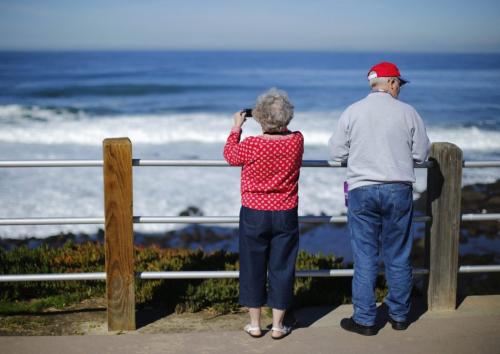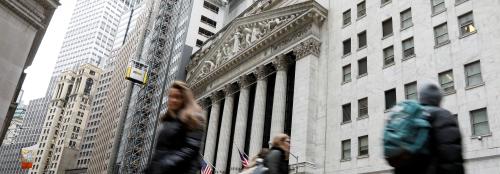This report is part of the Series on Financial Markets and Regulation and was produced by the Brookings Center on Regulation and Markets.
The Supreme Court’s 5 to 4 decision to side with American Express over Ohio, sixteen other states, and the United States, further ensconced our current payment system, which rewards the wealthy while penalizing the poor. America’s payment system has become a silent reverse Robin Hood system transferring billions of dollars from working and middle class Americans who use cash, debit and pre-paid cards, to the wealthy through elite platinum and black cards. This network exists in the quiet space, not subject to taxes, or according to the Supreme Court of America’s anti-trust system, which was the basis the case was argued on. The Supreme Court’s narrow majority, written by Justice Thomas, missed an opportunity to address the fundamental economic policy challenge of our time: reducing income inequality. Here is why the Court’s ruling will have the ramification of further cementing our nation’s growing wealth divide.
The American payment system functions as a hidden method of increasing income inequality. The wealthier you are, the less you pay for the same thing. In the aggregate there are billions of dollars of value in which lower income people subsidize the wealthier through a bizarre and opaque reverse Robin Hood system.
Although we all experience it every day, most of us have never thought about the economics and law behind that moment at the cash register when we pay for something. When the merchant asks you ‘cash or credit?’ or the screen prompts ‘Credit or Debit’ your choice makes a difference in what the merchant ultimately receives. Select debit or credit and your payment enters into an archaic labyrinth of payment processor, merchant and correspondent banks, that ultimately ends with the merchant receiving anywhere from 90 to 99 percent of the price at the register.
It may sound surprising, but if you buy a $4 cup of coffee on a fancy credit card, the coffee shop may spend 10 percent or more processing your payment—often more than the actual coffee beans cost. The path each payment method takes can be complex, but the outcome is fairly straightforward. Hand over cash and the merchant pockets everything. Use a prepaid card (America’s fastest growing type of payment at 1 out of every 10 card transactions) and merchants will lose a little. Debit Cards used to cost between 1 to 3 percent of the total transaction, but the Dodd-Frank Act required the Federal Reserve to lower fees, and now the merchant pays a combination of a flat fee of just over 20 cents plus 5 basis points (0.05 percent) of the transaction. Use a typical Visa or Mastercard branded credit card and the merchant will probably pay fees ranging in the 2 to 3.5 percent range. Leave home with an American Express and the merchant will pay even more, approaching 3 to 5 five percent, depending on how much you charge.
At issue before the court was whether or not the merchant could charge customers different prices depending on how they choose to pay. American Express has written into merchant agreements prohibitions against charging customers who use AmEx more, even though it costs merchants more to process AmEx cards. Merchants can choose not to accept AmEx, and many do, but for those that choose to take AmEx— requiring merchants to charge the same price means that customers who use cheaper forms of payment are in effect subsidizing AmEx card holders. While it is only a few percentage points of each transaction, this subsidy adds up.
Fees charged to merchants can be more profitable to credit card companies and banks than interest payments on the card itself. American Express reported nearly $5 billion in profits on these interchange fees in one quarter alone. That same quarter AmEx reported just under $2 billion in earnings on interest payments by card holders. People who pay their credit card bill on time can be extremely profitable customers, as long as they charge a lot.
People who pay their credit card bill on time can be extremely profitable customers, as long as they charge a lot.
Here is where the reverse Robin Hood kicks in. Credit card companies share some of this bounty with you: rewards. Rewards come in all flavors: frequent flier miles, hotel points, and cash back. The competition for rewards has become fierce. Some companies now offer ‘first opportunity to purchase’ for select concerts, and ‘unique private experiences’ that are not even for sale, such as a private tennis lesson from Andre Agassi.
Take a wealthy family that charges $80,000 a year in credit cards, earning 1.5 percent cash back. That comes out to a nice $1,200 check, which is not subject to federal or state income tax since it is considered a rebate and not income. For this family that is probably equal to a $2,000 a year raise in their pre-tax earnings. That is equal to almost two weeks of total earnings for the median American family who earns $60,000 a year (which would be $1,150 per week). That’s right, a wealthy family may earn in credit card cash rewards the same value as a two-week paid vacation for the average American household.
Lower income households systematically do not use or have access to elite payment mechanisms. Payment usage is inversely related to perks. The poorest tend to use cash, followed by prepaid cards, and then debit cards. Even if they use credit cards, the higher rewards cards are reserved for wealthier customers. Those rewards aren’t free. If merchants are not allowed to change the price despite different payment costs, the end result is that they are paid for out of the totality of the system. This point was understood by Justice Sotomayor who pondered the question from the bench: “If I go to a cash register and the merchant says to me, ‘I’ll give you a 1 percent discount today if you don’t use AmEx, I sit there and think to myself, ‘Do I need the airplane rewards or the train rewards, or do I want the 1 percent?’
The inefficiencies of the current payment system cry out for new financial technological solutions. FinTech thrives on disrupting inefficient systems. Card based payment systems are inefficient in both critical aspects: the pricing is too high for the merchant, and the process for the customer is too slow (especially with the new ‘Chip Cards’ that are even slower than swiping). The inability for new entrants to innovate is a factor in considering the monopolistic power of a market, which is part of what the Supreme Court was considering.
FinTech will have a difficult time breaking into the market when existing payment systems are able to provide substantial benefits to wealthier consumers. If merchants are unable to price discriminate on payment form, then the existing subsidy to the rich will continue and they will not be incentivized to change their card usage. Why give up those rewards to use a new FinTech system that offers you less?
Hence, many major FinTech payment systems like ApplePay are focusing on first tackling the inefficiencies of the speed and convenience of the swipe or chip system. ApplePay is really a new method of using the same old credit cards, just with your phone instead of plastic. In fact, Apple’s profit is an additional 50 basis points (1/2 of 1 percent) of payment processing fee, a reason why some merchants are hesitant to accept ApplePay. FinTech and innovation will likely be hampered for years as a result of this decision that reaffirms the status quo of significant rewards and incentives for big spenders.
The Court missed a major opportunity to move the ball forward on this reverse Robin Hood payment system. As Justice Breyer correctly stated in his dissent:
“[M]erchants generally spread the costs of credit-card acceptance across all their customers (whatever payment method they may use), while the benefits of card use go only to the cardholders.”
Thus, most Americans will continue to subsidize AmEx card holders. Ironically, what is in the wallet of most of the Justices deciding this case probably benefits them a lot more than what is in the wallet of most voters.






